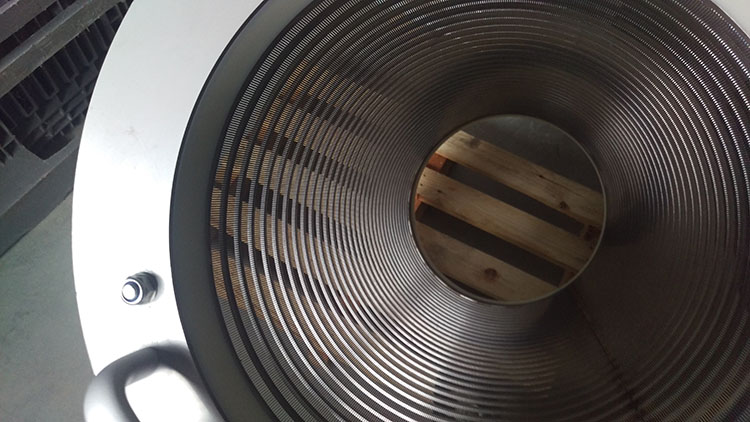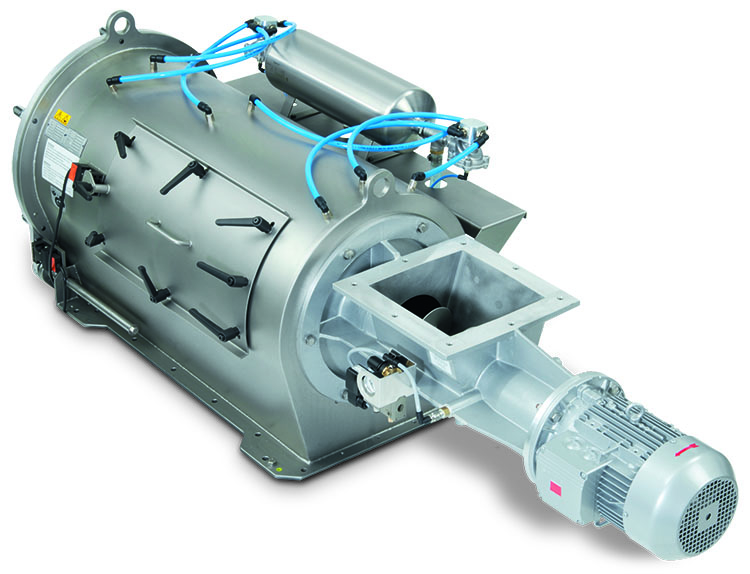
Consumers attach great importance to flawless products. Flours are important raw materials that must conform exactly to specifications in this respect. Rotary screen machines with stainless steel sieves ensure safety in the production process, as confirmed by several tests.

Raw materials handling in the baking industry is highly diverse and consists of many individual steps from incoming raw materials and warehousing to processing and packing. However, whereas planners and business economists take an overall view of the process, it’s often the details that decide success. If just one component operates sub-optimally, e.g. too slowly or not sufficiently accurately, or if its hygiene is not entirely faultless, the entire concept starts to falter.
Sieving machines, for example, are under scrutiny in several respects in this connection. They not only ensure that the product is hygienically faultless, e.g. by removing stones or insects, but are also responsible for the correct particle size distribution in flours. This in turn plays a decisive part in subsequent processing and for the quality of the end product.
Various different types of sieve are used in the baking industry. For example, vibration sieves with horizontal screen decks are typical. Normally, each screen deck is mounted in a circular frame and also has a series of screen cleaners such as rubber or plastic balls or cubes. These cleaners strike against the underside of the deck while the sieve is in operation, to prevent the deck being blinded. A drive mechanism ensures a short linear backward and forward movement, while simultaneously moving each sieve vertically.
Another method is the rotary sieve, consisting of a stack of several square screen decks. A drive mechanism transmits a circular movement to the sieve decks in a horizontal plane. The horizontal sieve screen and the absence of vertical movement create a gentle sieving movement. This maintains the natural layering of the material, with fine particles against the screen and coarse particles at the upper surface of the material bed.
Rotary sieves have a built-in screw conveyor that feeds the product into the sieve through an inlet housing. For this purpose, a drive motor mounted on the flange drives the feeder screw and perforated screen drum and the sieving mechanism. The screw then conveys the product to the pre-sieving drum and to the screening unit, where rotating paddles in the chamber accelerate its movement and swirl the product through the sieve. This high speed moves the particles to the deck surface several times, thus increasing the probability that all the particles really will pass through the sieve.
High capacity and long lifetime
Zeppelin Systems rotary screening machines (e.g. the RS 3 or RS 7) have proved successful for many years to process powdered bulk goods in the food industry. They are used as a secondary screen downstream of silos, below filling points and containers, and as inline sieving machines for pressure-tight operation from -0.4 bar (gauge) to +0.8 bar (gauge) in pneumatic conveyor lines and unpressurised directly under containers. There is a large selection of screen basket variants, in different construction materials and with different mesh and gap widths and perforation diameters.
In general, rotary screening machines have a compact, robust, low-vibration construction, specially designed for high capacity and long lifetime. The feed screw and striking mechanism, for example, have double bearings. Automatic screen basket clean-out is another option.
In the RS 7 rotary screening machine, for example, coarse pieces of product that could damage the sieve are separated from the product stream beforehand by a pre-screen basket with a 10 mm mesh width, and are carried to the coarse material outlet. The coarse material outlet is closed with a leak-tight coarse material bag or alternatively sealed by a pneumatic isolation flap valve. Emptying the coarse material cylinder on sealed pressurized machines can take place during conveying. The sieved bulk material is passed through the fine material collection cone for further use.
Many aspects of safety
The rear cover, on which the seal and shaft bearing are mounted, can be dismantled to change the screen or make a general visual inspection of the sieve drum. A safety end switch ensures that the machine cannot be switched on when the rear cover is removed. On the larger RS7 sieve machine, inspection of the sieve drum can also take place through the inspection opening at the side, which is also secured.
All components in contact with the product are of food grade quality and are designed based on BG (trade association) regulations and following the EHEDG (European Hygienic Engineering and Design Group) guidelines, and are accor-
dingly easy to clean. The design of the screen basket also contributes to this. It is easy to inspect by using the inspection openings at the side of the sieving machine, and to clean and if necessary to replace. Of course, the rotary sieving machine is also available in a model complying with the ATEX (Explosive Atmospheres) Directive 94/9/EG for use in Zone 21 or 22.
The screen basked can be fabricated from polyester or 1.4306 stainless steel. A slotted screen basket is recommended as a particularly robust variant.
What to do if a sieve breaks?
Every polymer screen breaks in the course of time. To detect such a screen break, these sieving machines can be fitted with an optional automatic screen basket monitor (Screen-D-Tect). This continuously monitors the state of the special screen cloth in ongoing operation. It operates by constantly measuring the electrical resistance, which abruptly changes when there is a screen break. This minimizes production downtime, and product can be isolated immediately before the raw material is processed. It also guarantees that previously produced product is still OK. When using a daily visual inspection, at least a whole day’s batch would have to be discarded. This method functions very well for a large number of applications.
On the other hand, a disadvantage when using normal polyester cloth is that it cannot be detected by the usual means. Stainless steel slotted screen baskets provide entirely different opportunities. The big advantage: stainless steel can be detected. This provides a greater safety factor if a screen breakage occurs and very tiny materials get into the sieved material. It would then be possible to identify these batches easily and reject them at an early stage. Therefore this variant is attractive mainly for companies with hygiene-sensitive products. There are usually no problems in replacing a polymer screen with a stainless screen, even with older sieving machine models.
The route to the perfect sieving machine
The studies were modeled on test methods of the American Institute of Baking (AIB) an. The Technology and Information Transfer Center for Bakers and Food Processors is composed of experts from the areas of baked goods production, experimental baking, cereals science, nutrition, food safety and hygiene. Many foodstuffs industry companies even rely exclusively on AIB-certified components. Thus it is an ideal partner when there is a need to test the suitability of components with regard to safety, quality and hygiene.
These tests dealt mainly with the central question as to whether flours can be screened just as safely using a rotary sieve machine with a stainless steel slotted screen basket as they can with polyester cloth screens. The background is that the mesh shape in polymer screens is rectangular, whereas for fabrication technology reasons the openings in a stainless steel slotted screen basket have a square shape as elongated slots. In theory, this could lead to increased penetration ability in the case of elongated foreign material.

The rotary screening machine is used as a pre- and post-sieve in various industries, under silos and upstream of containers, or in loading stations
Detailed studies
First of all, a test was carried out to discover whether the sieving machine fulfilled the AIB’s specifications in principle. These tests were passed successfully. Thus it was possible to screen flour with the recommended 30 mesh even into various different sieve equivalents.
This was followed by various investigations in which foreign material was mixed into the material being screened. The foreign material differed in nature (e.g. glass, paper, plastic, small stones or hairs), size (e.g. starting at a thickness of 1 mm) and shape (elongated, circular etc.). In another series of tests, the input material was mixed with insects (e.g. Tribolium confusum – the confused flour beetle). All the tests were carried out in the company’s own test installation at the Rödermark site on the RS7 rotary sieving machine.
It involved testing various different foreign materials and sizes. First of all, the cone was filled with 50 kg of flour and the foreign materials were added by hand. The sieving machine was then started. A further 150 kg was then added and sieved. The machine and the screen were then cleaned. The sieved flour and the flour from the inside of the screen were then sieved by hand. All the foreign materials that were found were collected and analyzed. Each experiment was repeated three times. The result was clear: 99% of the foreign objects mixed into the material to be sieved were sieved out by the rotary sieving machine.
The question as to whether a higher degree of protective screening in the case of insects/insect parts is achievable when using the RS 7 was interesting, especially with regard to the preparation of kosher and halal products. Although it would be necessary for further tests using weighed screenings to be carried out for official certification, the sieving results here were convincing.
Summary
In tests modeled on the AIB method, it was possible to confirm that high quality standards can also be satisfied when using slotted screens in a rotary sieving machine. Of the added foreign objects, 99% were reliably sieved out. Polyester screens are adequate for many applications in the foodstuffs industry. However, stainless steel screens are recommended if higher requirements are imposed, especially with regard to detectability. In practice, it is helpful that a polymer screen can be replaced by a stainless steel sieve at no great expense, even in older machines.
Author: Sven Schwelgin


